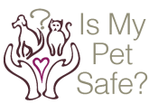Deicing and Pets
December heralds winter weather for most of North America and that means snow and ice (recent heat waves not withstanding). As home owners, we are most often concerned with the quick removal of ice from walkways to avoid potential injury and liability. But what about our role as pet parents?

Background
Pet parents must be concerned with the effects their choice of ice melt may have on their pet's health. Most have probably been swayed at some time by marketing for "green" or "pet friendly" mixtures. Let's get something out of the way: none of these products is 100% safe. Statements of safety are based upon potential harmful effects on healthy pets and when the product is used precisely as directed. So what we are really dealing with is a relative safety that must also include the context of exposure.
There are two types of exposure to these products: external surface contact or internal by ingestion. Contact with the ice melt may be when it is in solid form (rocks/chips/pellets) or in some cases, in a brine solution with melted ice. Surface contact is most likely to be on the paws from walking over ice or through melted puddles. Eyes can also be affected if they come in contact with powdery dust/residue. For this reason, never apply any ice melt product with a pet nearby.
If your pet is prone to eating anything, no matter the taste, use extreme caution with deicers as ingestion of these products can be extremely dangerous.
Common deicing chemicals:
| Common Name | Temp. Limit | Cost | Notes | |
|---|---|---|---|---|
| Carbonyl Diamide (Urea) | 25F | low | Least effective deicer | |
| Potassium Chloride (KCl) | 25F | high | Can be lethal to pets with CKD | |
| Sodium Chloride (NaCL) | 20F | low | Lethal in large quantities (>4g/kg) | |
| Calcium Magnesium Acetate (CMA) | 20F | high | May damage concrete | |
| Magnesium Chloride (MgCl2) | -15F | moderate | Can be lethal to pets with CKD | |
| Calcium Chloride (CaCl2) | -25F | moderate | Fastest acting |
ismypetsafe.com provides thoughtful recommendations based on the best facts we can find but we are not veterinarians! Always speak to a medical professional if you believe your pet may be ill.
Urea based deicers are the one most often marketed as "pet safe" and can be recognized by their characteristic green color. Unfortunately, urea is not very good at melting ice, even at relatively high temperatures of 25-30F - lots of little surface holes melted in the ice but that's about it. That ineffectiveness leads to wasteful over use to compensate, often damaging plants in the process. If you are in a relatively warm winter climate and only see ice briefly and in thin layers, urea will probably be good enough and avoids many pet related problems. Ingestion of small to moderate amounts should only cause some gastrointestinal upset but in larger doses urea can cause problems with red blood cells. Call your vet immediately if you suspect your pet has eaten a large amount of urea type deicer or shows signs like shortness of breath, fatigue or dizziness.
[UPDATE] A few have mentioned a popular urea based product on the market that was 'developed with veterinarians" and is claimed to work down to around 15F. Most say it does not work well (as expected) at the colder temperatures. But more important: it contains propylene glycol, an additive that is safe for dogs but banned for use as an additive in cat food due to links to Heinz body anemia.
Potassium chloride is another product that works best in areas that don't see very cold temps. Though more expensive, it is regarded as not damaging to walks and roads. It is also less damaging to plants than many alternatives, though can be slower to act than sodium chloride. From a pet standpoint, it is fairly safe to use around healthy pets. However, if your pet has chronic kidney disease (CKD), ingestion can be fatal as the kidneys are unable to remove the excess potassium. Even with an otherwise healthy pet, ingestion is likely to cause severe gastrointestinal symptoms and may cause hemorrhagic gastroenteritis at high quantities. Be prepared to contact your vet immediately if your pet shows signs of gastronomic distress.
Sodium chloride, more commonly known as rock salt, is cheap, moderately effective, can damage just about any surface at high enough concentrations and is generally not pet friendly. In part because it is applied very liberally, many pets suffer discomfort from mild to moderate burns caused by walking over areas where rock salt has been spread. Ingesting small mounts can lead to gastrointestinal discomfort but in larger quantities, sodium chloride can be fatal. If you suspect your pet has consumed more than a very small amount of rock salt, contact your vet for instructions as soon as possible - your pet may require intravenous liquids and electrolyte monitoring.
Magnesium chloride is moderately priced, can damage asphalt and cause scaling on concrete. Though it technically has a low effective temperature, in moderate temperatures (20-30F) it is often slower to act than cheaper rock salt. Marketed as pet friendly due to its reduced tendency to burn paws, it can be lethal to pets that suffer from CKD (their kidneys are unable to filter out the excess magnesium resulting in severe electrolyte imbalances.)
Calcium Magnesium Acetate, many times seen abbreviated to CMA, is expensive, not good in very cold climates, slow acting and may damage concrete. However, it is favored by many municipalities as it is less corrosive to metal equipment than other products thus resulting in net savings. CMA is usually sold to consumers as a minor part of a mixture with sodium and/or potassium chloride.
Calcium Chloride is the fastest acting deicer and also works at the coldest temperatures. Like rock salt, it may burn paws and it can leave a white residue if tracked into the home. However, if used as directed, the risk of burns or irritation is reduced.
Both CMA and Calcium Chloride can cause severe gastrointestinal reactions if ingested.
Takeaways
So how risky are these products and which should you use? If used as directed and with some common sense, all of these products should be safe for use around healthy pets who are past the stage of sampling everything they find on the ground.
Before going further an important point: do not over apply deicers. For instance, the amount of calcium chloride necessary to melt a walkway is far less than any other product. Yet, perhaps because they are use to rock salt or "pet friendly" products, people have a tendency to over spread. And dispensing more of the weaker products (i.e., urea or rock salt) probably will not make it melt your ice better or faster.
For a light amount of ice that is likely to melt in the sun later in the day, consider using a little sand instead (the environment will be happier too).
The biggest risk is ingestion. That can happen from actually eating the product off the ground or from licking paws once back inside. None of these deicers taste good and in fact, most will burn to some degree or another in the mouth. So in most cases it is unlikely your pet will eat more than a very tiny amount off the ground.
You know your pet best, so act accordingly!
As to licking paws that may pick up salt dust or wet brine that later dries, the amount ingested at any one time is likely to be small but could be enough to cause some gastronomical discomfort or mild buring of gums and tongue. If you see your pet licking their paws excessively, wipe the paws down and keep an eye on them for any sign of illness.
All of these risks can be avoided to a large degree by exercising some common sense.
- Only apply as much of the chosen product as is absolutely necessary to do the job,
- Do not apply the product when your pet is nearby,
- Give the deicer a chance to work before walking your pet on treated areas,
- Clear excess melted water and ice fragments so your pet does not need to walk through puddles of brine
- When there is grass or snow adjacent to the walkway, encourage your pet to traverse over that until the walkway is clear,
- Keep wet rags or a small container with lukewarm water near the door so you can clean your pet's paws if they have walked over salt or through brine
- Avoid salting walks with high pet traffic, such as to kennels
- Consider using sand or fine pea gravel as an alternative, alone or mixed with small amounts of deicer
The bottom line is that pet parents should not be fearful of using deicing products but they do need to think first, walk second and keep an eye on their pet for any adverse reactions.
Readers who live in planned communities and do not have input or control over the use of deicers are best advised to carry their pet over any walkway with freshly spread deicer. Encourage your pet to step in fresh snow (if available) and wipe down or wash their paws on your return. While you can ask your managing agent to reduce the amount of material spread on the walk, liability concerns push associations to err on the side of too much rather than too little.
Our view
Though more prone to burn, calcium chloride is my choice as I am in a cold climate area. To me, it is better to use the fastest acting deicer that requires the least amount of product to do the job. I have never found rock salt to be effective at anything other than tracking itself inside my home and the urea based products won't work at all below 25F.
I also keep a pair of ice cleats to wear on my shoes for times I need to go out before deicing or if there is only a little bit that will later melt in the sun. When I do use a deicer, I always try to time use between dog walks and if possible, later sweep away melt water and any remaining loose ice.


